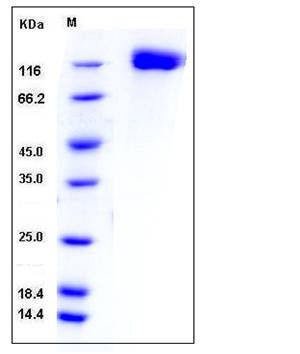Mouse OSMR / IL-31RB Protein (His Tag)
OSMRB
- 100ug (NPP3434) Please inquiry
| Catalog Number | P50500-M08H |
|---|---|
| Organism Species | Mouse |
| Host | Human Cells |
| Synonyms | OSMRB |
| Molecular Weight | The secreted recombinant mouse OSMR consists of 726 amino acids and has a predicted molecular mass of 83.7 kDa. In SDS-PAGE under reducing conditions, the apparent molecular mass of rmOSMR is approximately 120-130 kDa due to glycosylation. |
| predicted N | Glu 24 |
| SDS-PAGE |  |
| Purity | > 97 % as determined by SDS-PAGE |
| Protein Construction | A DNA sequence encoding the mouse OSMR (O70458-1) extracellular domain (Met 1-Leu 738) was expressed, fused with a polyhistidine tag at the C-terminus. |
| Bio-activity | |
| Research Area | Cardiovascular |Angiogenesis |Cytokines / Chemokines in Angiogenesis |IL6 Related |
| Formulation | Lyophilized from sterile PBS, pH 7.4 1. Normally 5 % - 8 % trehalose and mannitol are added as protectants before lyophilization. Specific concentrations are included in the hardcopy of COA. |
| Background | Oncostatin-M specific receptor subunit beta also known as the oncostatin M receptor (OSMR) and Interleukin-31 receptor subunit beta (IL-31RB), is one of the receptor proteins for oncostatin M. OSMR is a member of the type I cytokine receptor family. IL-31RB/OSMR heterodimerizes with interleukin 6 signal transducer to form the type II oncostatin M receptor and with interleukin 31 receptor A to form the interleukin 31 receptor, and thus transduces oncostatin M and interleukin 31 induced signaling events. Mutations in IL-31RB/OSMR have been associated with familial primary localized cutaneous amyloidosis. Defects in IL-31RB/OSMR are the cause of amyloidosis primary localized cutaneous type 1 (PLCA1), also known as familial lichen amyloidosis or familial cutaneous lichen amyloidosis. PLCA1 is a hereditary primary amyloidosis characterized by localized cutaneous amyloid deposition. This condition usually presents with itching (especially on the lower legs) and visible changes of skin hyperpigmentation and thickening (lichenification) that may be exacerbated by chronic scratching and rubbing. The amyloid deposits probably reflect a combination of degenerate keratin filaments, serum amyloid P component, and deposition of immunoglobulins. |
| Reference |
